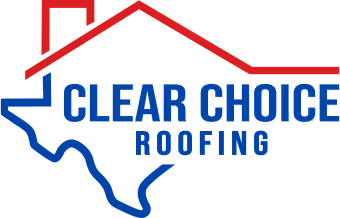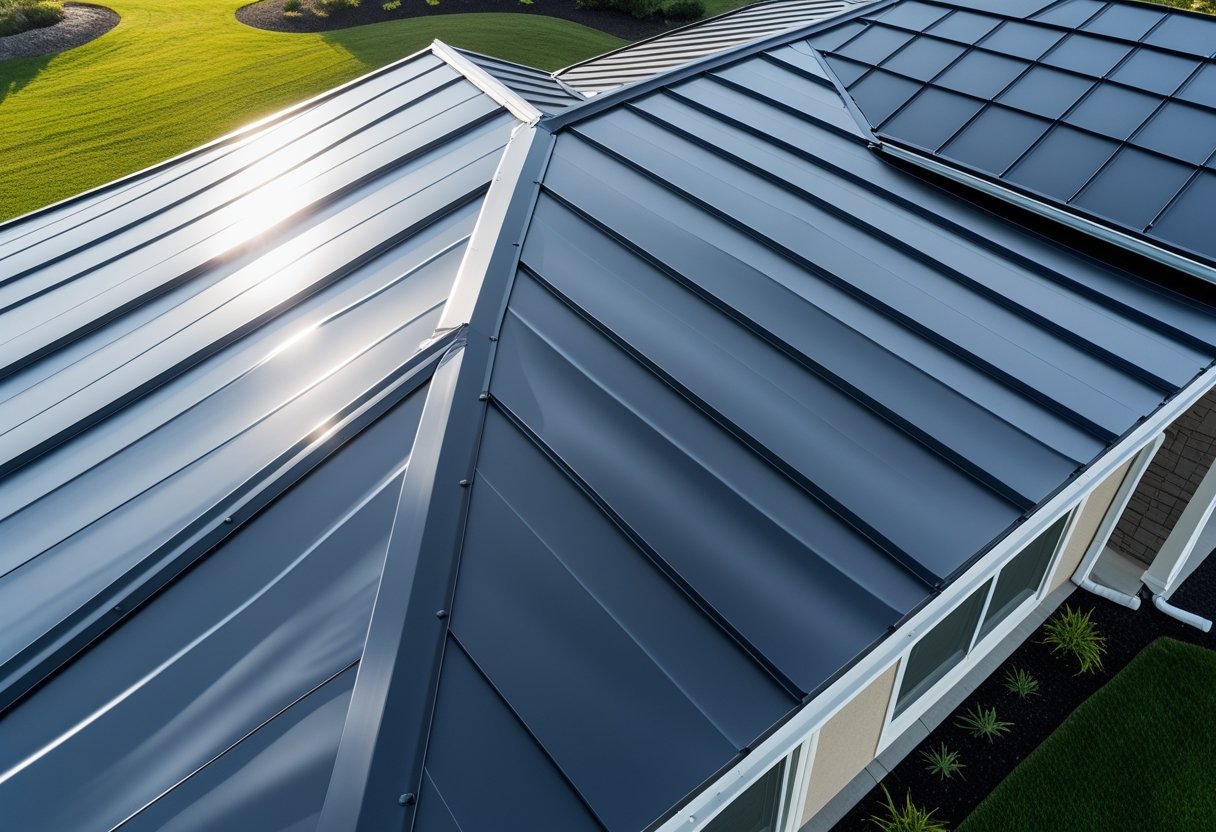So, is a metal roof better than shingles? Most of the time, yeah—metal roofs are tougher, last a lot longer, and can save you money down the road. Asphalt shingles might be cheaper upfront, but metal roofing stands up better to wild weather and usually needs less fixing as the years go by. If you’re hoping for a roof you won’t have to worry about for decades, metal’s a pretty smart bet.
But picking the right roof depends on what you care about most. If you’re counting every dollar, shingles might catch your eye. Still, if you want something that shrugs off storms, resists wear, and keeps your home cooler, metal is definitely worth a look. Here at Clear Choice Roofing, we help Austin homeowners weigh the pros and cons and make sense of what matters for their homes.
Comparing Metal Roofs and Shingles
Let’s get into the basics. To really compare metal roofs and shingles, you need to know what they’re made of, what they cost, and how they actually hold up. Here’s the gist, without any sales pitch.
Overview of Roofing Materials
Metal roofs use steel, aluminum, or copper. These panels are tough and laugh off bad weather. With some basic care, metal roofs will stick around for 40 to 70 years.
Shingles, usually asphalt, are the go-to for most homes. They’re cheaper up front, come in sheets, and last about 15 to 30 years if you’re lucky.
You can find both in plenty of colors and styles, but metal tends to win on energy savings. Your choice changes not just how your house looks, but how it holds up and what you’ll spend later.
Basic Differences
The big one? Upfront cost. Metal roofs run about $8 to $12 per square foot, while shingles are more like $3 to $6. So, yeah, metal costs more at the start.
But metal roofs outlast shingles by decades and handle rough weather better. They also bounce back more sunlight, which can mean lower cooling bills.
Shingles are simpler to install and fix, but they’ll need replacing sooner. Think about what you’re willing to spend now, and what you’ll want to avoid spending later.
How Each Roof Type Works
Metal roofs use big panels that lock together, sealing out water and wind. Since they don’t soak up water, there’s not much chance for mold or mildew.
Shingles overlap like fish scales, so water slides off, but wind can sneak underneath and damage them. They also soak up heat, which isn’t great in a Texas summer.
Installing metal takes a skilled crew—like ours at Clear Choice Roofing—since everything has to fit just right. Shingles are easier and faster to patch up, but you’ll probably be doing that more often.
Durability and Lifespan
Let’s be real: how long your roof lasts and how much TLC it needs makes a huge difference. Here’s what to expect.
Expected Longevity
Metal roofs stick around for 50 to 70 years, especially if you go with steel or aluminum. They resist rust, too. Shingles, on the other hand, usually give you 20 to 30 years, depending on the weather and material.
Slate and tile roofs can last even longer, but they’re pricey and tricky to install. Metal hits a nice sweet spot between long life and reasonable cost. At Clear Choice Roofing, we put a lot of effort into using the best materials and workmanship so your roof lasts as long as possible.
Resistance to Weather
Metal roofs shrug off heavy rain, snow, and wind. They also reflect sunlight, which keeps your home cooler. Shingles can warp or crack if it gets too hot or cold, so they’re not always the best in extreme climates.
No matter what you pick, installation matters. If you want to avoid leaks, you need a crew that seals things up tight.
Common Maintenance Needs
Metal roofs are pretty low-maintenance. You might have to check for loose panels or a bit of rust every few years, but that’s about it.
Shingles, though, need more attention—replacing broken or missing pieces, cleaning off moss or algae if you live somewhere damp. Cleaning a metal roof is usually just a rinse with a hose.
Either way, it’s smart to get professional inspections every couple of years.
Costs and Value
Let’s talk money—what you pay up front, what you might save later, and how insurance plays into all this.
Initial Installation Expenses
Metal roofs cost more to put on. Covering a 1,500-square-foot home with metal might run $7,500 to $15,000. Shingles? More like $5,000 to $10,000. For a 2,000-square-foot roof, shingles could be about $7,900, while metal might jump to $18,600.
That’s a chunk of change, but you’re also buying peace of mind and fewer headaches down the road. With Clear Choice Roofing, you’ll get solid materials and a careful install, whichever way you go.
Long-Term Savings
Metal roofs last two or three times longer than shingles—think 40 to 70 years versus 15 to 30. So you’re not replacing your roof every couple decades. Metal also reflects heat, which can cut your cooling bills.
Shingles are cheaper to start, but you’ll probably pay more over the years since you’ll need to replace them sooner.
Insurance Implications
A metal roof might actually lower your insurance bill, since it’s more fire- and weather-resistant. Some insurers give discounts for that. Shingles don’t offer as much protection, so you may pay a bit more.
Before you commit, call your insurance company. Ask about possible discounts for metal. We can help with the paperwork if you need it.
Energy Efficiency and Environmental Impact
What you put on your roof affects how your house handles heat, your energy bills, and even the planet. Here’s the scoop.
Insulation and Heat Reflection
Metal roofs reflect sunlight, sending a lot of the sun’s heat away. Asphalt shingles soak it up, which can turn your house into an oven in summer.
If you want to keep things cooler inside—especially in Texas—metal’s a good move. Less heat getting in means your AC doesn’t have to work so hard.
We often recommend metal if you care about better temperature control. It just makes life easier when it’s blazing outside.
Recyclability of Materials
Most metal roofing is steel or aluminum, which you can recycle almost endlessly. When it’s time to replace the roof, the old stuff gets melted down and reused, not dumped in a landfill.
Shingles? Not so much. Some can be recycled for road paving, but a lot just end up as waste.
If you’re thinking about sustainability, metal has a clear edge.
Impact on Utility Bills
Since metal roofs reflect heat, you’ll probably pay less for cooling in the summer. Lower energy bills can help offset the higher upfront cost.
Lots of our customers have seen their electric bills drop after switching to metal. If you want to save every month, metal’s worth a look.
Curb Appeal and Design Options
Metal roofs can totally change your home’s vibe. Tons of color and style choices mean you can match your house or go bold. They work with all sorts of house styles, from old-school to ultra-modern.
Color and Style Choices
There are loads of colors—earthy browns, cool grays, fire-engine reds, you name it. You can blend in or stand out, whatever fits your style.
Styles? You’ve got options: smooth panels, ribbed sheets, even metal shingles that look like wood or asphalt. You can get the look you want and still have all the perks of metal.
Some finishes reflect sunlight better, too, so you can pick a color that helps keep your home cooler. We’re happy to help you sort through the choices.
Architectural Compatibility
Metal roofing fits a surprising range of homes. It can look sleek and modern, or you can use metal shingles to fit in with a more traditional look.
Got a craftsman or historic home? There are metal styles that won’t mess with your home’s character. Metal’s flexible, too—it can be cut to fit odd shapes, turrets, dormers, whatever you’ve got.
You don’t have to change your home’s design to get a metal roof. We’ve installed metal roofs on all kinds of houses around Austin.
Installation Considerations
Putting on a metal roof or shingles isn’t the same process. There are different challenges, and you’ll want to know what you’re in for. Here’s what to expect.
Ease of Installation
Shingles go on fast—one to three days for most homes. They come in small pieces, and most crews can nail them down pretty quickly.
Metal roofs use bigger panels or strips, which take more time and careful handling. You’ll need special tools and a crew that knows what they’re doing. If you’re installing metal over shingles, it might take longer since you have to prep things like ventilation and moisture barriers.
Metal needs precise measurements and lining up. If you get it wrong, you could end up with leaks or wind issues. At Clear Choice Roofing, we obsess over the details to make sure everything lines up and lasts.
Required Expertise
Installing a shingle roof doesn't take much specialized training—most roofing crews know the ropes, so finding a contractor is usually pretty straightforward (and not too pricey).
Metal roofs? That's a different story. The installer really needs to know their stuff: cutting panels, securing fasteners, getting ventilation right. If they mess up, you could have moisture problems or a roof that wears out way too soon.
Honestly, if you go with a contractor who hasn't done much metal work, you might be calling them back for repairs or just dealing with a roof that doesn't perform well. It's probably safest to hire someone like Clear Choice Roofing, where the crews actually get trained on metal installs. That way, your roof should last decades and your home stays protected.
Suitability for Different Climates
Where you live—and the kind of weather you get—matters a lot when you're picking between a metal roof and shingles. Some roofs handle heat better, some hold up in storms or snow. It’s worth thinking about how each type performs before making a decision.
Performance in Extreme Weather
Metal roofs do a great job with tough weather. They shrug off heavy wind, rain, and hail better than shingles. If storms are common where you live, metal can really cut down on leaks and damage.
Shingles can take a beating in harsh weather, especially big storms or hail. They also wear out faster in places that get a lot of hot sun.
Metal reflects sunlight, which keeps your house cooler in the summer. That can help with energy bills if you’re somewhere warm. Shingles soak up heat and might crack or fade faster in the sun.
Regional Recommendations
Hot places like Texas or Arizona? Metal roofs are usually a smart bet—they reflect heat and last longer, especially in dry climates.
If you’re up north, shingles can work, but you’ll probably have to keep up with maintenance after snow or ice. Metal sheds snow easily, so you won’t get as much buildup.
In rainy or humid spots, both types can work, but metal roofs usually do a better job stopping leaks and protecting your home for the long haul.
Noise, Comfort, and Everyday Living
Your roof choice isn’t just about weather—it's about how your house feels day to day, too. Noise and temperature play a real part in your comfort. It’s worth taking a minute to think about which roof fits your needs when it comes to daily life.
Sound Levels
Metal roofs can be noisier during rain or hail since sound travels through metal. With solid insulation, though, most folks barely notice. If you want a quieter house, shingles are naturally better at soaking up sound—storms just sound softer.
If you love the idea of metal but hate the thought of extra noise, ask about soundproofing. Clear Choice Roofing can add materials to cut down on the racket.
Temperature Regulation
Metal roofs bounce sunlight away, keeping your house cooler in hot weather—super handy in sunny places like Texas. That can mean lower AC bills and a more comfortable home.
Shingles, on the other hand, absorb heat, so your attic can get warmer. Good ventilation and insulation help, but if you want the coolest option, metal usually wins. In the winter, metal sheds snow fast, but that’s not a big deal unless you’re somewhere snowy.
Making the Right Choice for Your Home
So which is better—metal or asphalt shingles? It really depends on your priorities. Metal roofs last longer—sometimes 50 years or more—while shingles usually go for 20 to 30 years, so you’ll probably be replacing them sooner.
Metal’s more expensive up front. You might pay around $18,600 for a metal roof, while shingles could run about $7,900. But metal needs less maintenance and can save you money on cooling because it reflects heat.
Think about style, too. If you want a quick, affordable fix, shingles are fine. If you’re after durability and lower energy bills, metal might be worth the investment.
Here’s a quick side-by-side:
FactorMetal RoofAsphalt Shingles Lifespan50+ years20-30 yearsUpfront CostHigher ($18,000+)Lower (~$7,900)MaintenanceLowModerate to HighEnergy SavingBetter heat reflectionLess energy efficientStyle OptionsModern, sleekVariety of colors/styles
If you’re stuck, Clear Choice Roofing can help you sort through the pros and cons and give you a free estimate. No pressure—just honest advice.
Frequently Asked Questions
Metal roofs stick around longer, save on energy, and handle rough weather, but you’ll pay more upfront. Shingles are cheaper to install but might need repairs more often and don’t last as long.
What are the advantages of metal roofing compared to traditional shingle roofing?
Metal roofs are tougher and last longer. They don’t need much maintenance, and they help keep your house cooler by reflecting sunlight.
Can metal roofs withstand severe weather conditions better than shingles?
Absolutely. Metal stands up to wind, rain, and hail better than shingles, and it’s less likely to crack or break.
How do the lifespans of metal roofing and asphalt shingles compare?
Metal roofs can last 40 to 70 years, while shingles usually go 15 to 30 years. So you might replace shingles a couple times before a metal roof needs attention.
Is there a significant cost difference between installing a metal roof versus shingles?
Yes—metal costs more up front, sometimes more than double. But since metal lasts longer and needs fewer repairs, you might save money in the long run.
What are the energy efficiency considerations between metal roofs and shingle roofs?
Metal roofs reflect more heat, so your house stays cooler in summer. Shingles absorb heat, which can push your cooling costs up if you live somewhere warm.
How does maintenance for metal roofing compare to that of shingle roofing?
Metal roofs usually need less attention. Shingles? They crack, curl, and shed those gritty granules—so you might find yourself calling for repairs or replacements more often than you’d like. With metal, you’re mostly just looking at basic checkups and the occasional cleaning.
If you’re on the fence, Clear Choice Roofing can walk you through your options. They’ve seen it all and can help you land on something that actually lasts.



